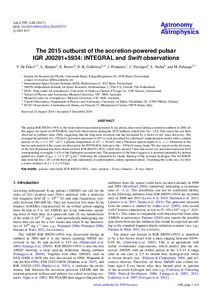The 2015 outburst of the accretion-powered pulsar IGR J00291+5934: INTEGRAL and Swift observations
De Falco V; Galloway DK; Bozzo E; Poutanen J; Stella L; Ferrigno C; Falanga M; Kuiper L
The 2015 outburst of the accretion-powered pulsar IGR J00291+5934: INTEGRAL and Swift observations
De Falco V
Galloway DK
Bozzo E
Poutanen J
Stella L
Ferrigno C
Falanga M
Kuiper L
EDP SCIENCES S A
Julkaisun pysyvä osoite on:
https://urn.fi/URN:NBN:fi-fe2021042716931
https://urn.fi/URN:NBN:fi-fe2021042716931
Tiivistelmä
The pulsar IGR J00291 + 5934 is the fastest-known accretion-powered X-ray pulsar, discovered during a transient outburst in 2004. In this paper, we report on INTEGRAL and Swift observations during the 2015 outburst, which lasts for similar to 25 d. The source has not been observed in outburst since 2008, suggesting that the long-term accretion rate has decreased by a factor of two since discovery. The averaged broad-band (0.1-250 keV) persistent spectrum in 2015 is well described by a thermal Comptonization model with a column density of NH4 approximate to 10(21) cm(-2), a plasma temperature of kT(e) approximate to 50 keV, and a Thomson optical depth of tau(T) approximate to 1. Pulsations at the known spin period of the source are detected in the INTEGRAL data up to the similar to 150 keV energy band. We also report on the discovery of the first thermonuclear burst observed from IGR J00291 + 5934, which lasts around 7 min and occurs at a persistent emission level corresponding to roughly 1 : 6% of the Eddington accretion rate. The properties of the burst suggest it is powered primarily by helium ignited at a depth of y(ign) approximate to 1.5 x 10(9) g cm(-2) following the exhaustion by steady burning of the accreted hydrogen. The Swift/BAT data from the first similar to 20 s of the burst provide indications of a photospheric radius expansion phase. Assuming this is the case, we infer a source distance of d = 4 : 2 +/- 0.5 kpc.
Kokoelmat
- Rinnakkaistallenteet [19249]
